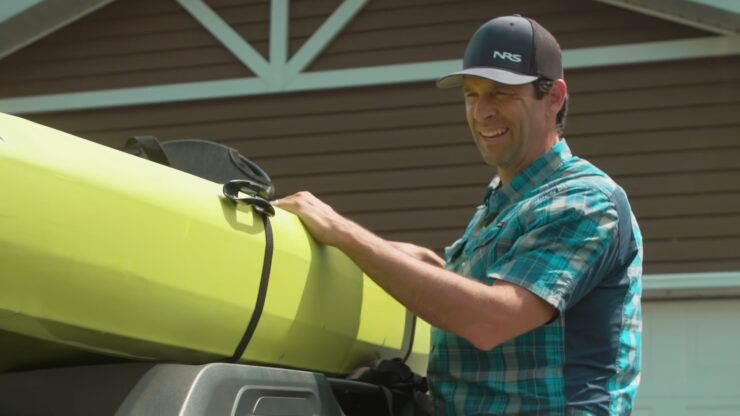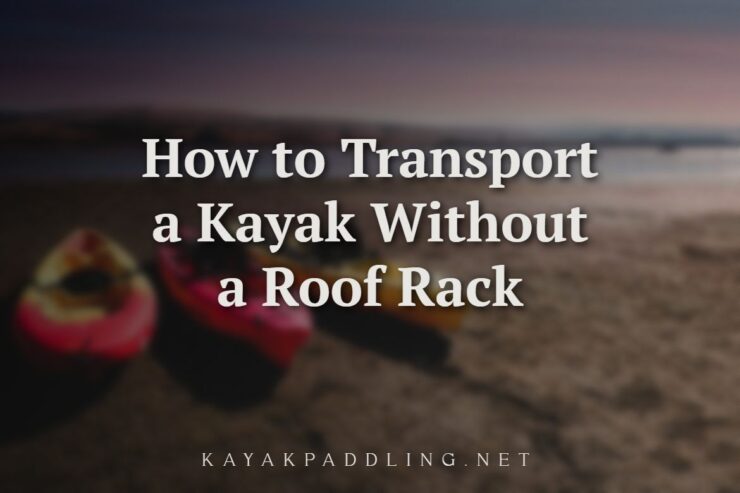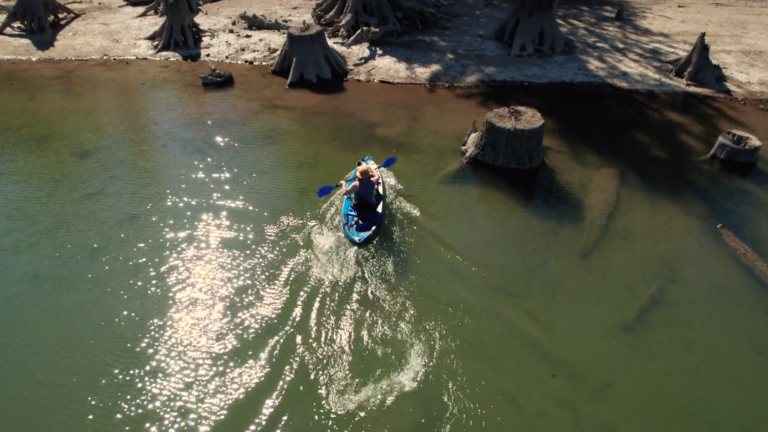Successfully kayaking involves more than just skillful paddling; it starts with proper care and transport of your kayak. Ensuring the safety and integrity of your kayak during transportation is crucial, whether you’re taking it home from the store or heading out to the water.
While SUVs and station wagons, with their built-in roof racks, make this task relatively straightforward, what can you do if you have a sedan, hatchback, or hybrid that lacks a roof rack? Even minor damage to the kayak’s hull can pose significant risks, including potential accidents or capsizing.

Your kayak’s performance could suffer due to dents or imperfections in its structure. To prevent this, it’s crucial to avoid placing your kayak on rough or uneven surfaces that could cause damage.
Moreover, dragging your kayak over long distances can cause deformities to its shape, affecting its performance.
Safety in kayaking isn’t just about what happens on the water; it starts the moment you acquire your kayak. If your vehicle doesn’t have a roof rack to securely hold your kayak, carrying it on your back isn’t a practical solution.
So how can you safely and effectively transport your kayak without a roof rack? Don’t worry; there are several convenient and efficient alternatives available for transporting your kayak without causing any damage to it.
We’ll guide you through various options suitable for vehicles that don’t come equipped with a roof rack.
Table of Contents
ToggleTransporting a Kayak without a Roof Rack
Let’s check them out to see how they work correctly.
1. Make a Roof Rack of Pool Noodles!
It is surprisingly impressive how the cut-down and not-so-firm pool noodles can be ironed for carrying kayaks over the car. Yes, apart from making wreath forms and stopping doors from slamming, the pool noodles could be a roof rack to accurately clutch the kayaks.
For this arrangement, pool noodles can be attached to the transport’s roof to support kayak shipping with comfort. It can be executed very quickly by aligning the following actions in a queue:
- Set the pool noodles properly on the car or truck’s rooftop, in an exact centerline.
- Move the ratchet band within the pool noodles’ narrow openings and wrap them around the roof sheet.
- Lift your kayak by getting others’ help to place it correctly in a horizontal position.
- Turn your kayak’s face downward. At this position, the kayak doesn’t miss its balance and remains clutched even in the windy driveway.
- Once fixed finely, bind down the kayak to the rooftop with stiff bands or strops, around the kayak up the roof and by the interior of your transport.
- Look at the exact locality of bow and stern if they are equivalent and stable.
- Drive mindfully to your purpose spot, seeing your rear reflector continually at curves, circles, and exchanges.
Monitoring the roads’ edges while driving with a kayak at the top allows you to pass by the other drivers on the road securely. You don’t intend to make anybody injured in a road accident if kayak displaces fall off the track.
Usually, for supporting a kayak firmly on the pool noodles roof rack, two or three pool noodles are enough. The compositional portability of pool noodles is quite similar to thermoformed kayaks as they are made up of polyethylene, which is a common material in kayaks and pool noodles.
Many drivers, if they transport heavy-weight kayaks, can also fix more than three pool noodles. There is no doubt that pool noodles have limitations to bear different burdens. And they can be compressed if not sustainable. Therefore, note the kayak’s weight and then arrange pool noodles accordingly. So, it can provide better security in carrying big boats and kayaks.
2. Get help from Kayak Trailers

From all manual settings out there to become a roof rack for holding the kayaks firmly, the only thing manufactured specifically for this task is a kayak trailer. It is an option many kayakers prefer, and it’s therefore becoming well-received among people today.
What do you have to do with the kayak trailer? Is it easy to fill with kayaks?
Not-so-hard adjustment is required to access the aid of the kayak trailer. You just have to drag and drop the kayak over it and connect its forearm with the back hook of the transport. It provides a substantial berth for kayakers to reduce bumping.
The cross arms and load bars of the trailers are responsible for stabilizing the position of kayaks. It is reliable to have this option if not have a solid iron rack over the vehicle for long distances and throughout the roads with more jumps or jolts.

Another benefit of having kayak trailers for transportation purposes is their capacity to add more than a single kayak at the same time. Even kayaks in many forms and sizes could be inserted and adjusted on trailers. They have straps linked with iron arms to wrap around kayaks and provide grip over maintaining the kayak’s posture.
Therefore, you can hatch a family trip with everyone’s individual-seating kayaks or plan a whole week adventure vacation to the seaside by reducing the constant load of kayaks over transport and putting them separately in a vast space kayak trailer.
3. Form Block Roof Rack
Compared to the pool noodles roof rack, the similar stuff that provides structure in moving your kayak across various locations is a Foam block. Exciting, correct? Foam blocks are no doubt extremely enduring and considerably simple to practice. The process of foam blocks is quite reliable for the design of pool noodles roof racks. The roof racks standing by foam blocks are suitable for short-distance drives or drives to nearby locations.
However, interstate transportation is based on standard safety precautions and some undeniable rules and conditions by road law followers. Thus, kayaks’ foam block carriage is short-term support but maintains kayaks’ protection precisely until the journey ends.
How could you arrange foam blocks for covering the balance of kayaks?
- Take two foam bars and place them on the transport rooftop.
- Set the kayak at the top of the foam squares and ensure it is accurately fixed.
- Bind up the kayak properly with bands. Bring the bands above and throughout the kayak from within the interior of the vehicle.
- Once packed, you can skillfully conduct the kayak to your address.
It is expedient when conveying a kayak to the other countries’ other side to adopt bow and stern fronts. Despite the fact that some kayakers go versus this, it serves to secure the kayak bands extra tight.
This would help you bypass taking your kayak and foam blocks split away in the windy weather while touring between countries. Without bow and stern lines, your kayak seems bumpy on your car roof and would be expected to drift off with an unexpected blow of wind. It doesn’t just break or injure your kayak; it can cause severe infliction to other inexperienced road drivers.
4. Drive by Placing Kayak Inside the Vehicle

This is an option that could help you transport kayaks from one place to another in the vehicle itself without external trailers and above the rooftop. If the vehicle is a Support Utility Vehicle SUV or transport with wide internal capaciousness, it can manage the length of kayaks inside it. Just pull down the last two seats and open the tailgate; you can fix the kayak inside the car. But it is not an all-time safest option to consider.
Not every vehicle is of the same type, nor can hold kayaks correctly. This ability appears in truck cars where kayaks of small size and splitting kayaks could be placed. The split kayaks could be turned into two to three halves that can be transported by twiddling inside a car.
If you drive a truck, you can always consider truck bed extenders that can increase the size of the truck bed by 20 percent, giving you more space to carry your kayak or other watercraft.
Sometimes the kayak could slip, and profound results could occur on a running road. A non-smooth track can cause the car basement to lose grip and fall off the kayak out from the car. Moreover, it’s one of the most dangerous things for inexperienced drivers to transport a kayak by crossing busy roads and circles.
5. Utilize Ratchet Straps or Cam Straps
No matter the method you choose, you’ll likely need straps to secure the kayak. Ratchet straps and cam straps are the most commonly used options.
Ratchet Straps

- Advantages: Ratchet straps are great for heavy loads and can provide a very tight fit.
- Disadvantages: However, they can sometimes be over-tightened, which might damage the kayak.
Cam Straps

- Advantages: Cam straps are easier to adjust and less likely to cause damage.
- Disadvantages: They may not provide as tight a fit, so you’ll need to check them frequently during your journey.
6. Try the Hitch-Mount Option

Hitch-mount carriers attach to the hitch of your vehicle, providing another way to transport your kayak without a roof rack.
Hitch-Mount Carriers
These carriers connect to the rear hitch receiver and extend backward, providing a platform for your kayak. They can be a good option for SUVs or trucks and are especially useful if your vehicle already has a hitch installed.
Limitations and Requirements
Before investing in a hitch-mount carrier, you should be aware of its limitations. Check the weight limits and make sure your hitch can handle the load. Remember that these carriers can add considerable length to your vehicle, which may make parking or turning more challenging.
7. DIY Solutions
If you’re handy, a DIY solution might be just the ticket. It allows for customization but requires some skills and tools.
PVC Pipes and Wooden Racks
Some kayakers have successfully built their own racks using PVC pipes or wood. These DIY options can be tailor-made to fit your specific needs, offering a cost-effective and customized solution.
Safety Precautions
If you decide to go the DIY route, make sure to follow all safety guidelines. This includes securing all connections properly and double-checking all attachment points. Your DIY rack should be as safe and secure as any commercially available option.
FAQs
Can I use a regular tarp as an alternative to foam blocks or pool noodles?
While a tarp can provide some level of protection between your car’s roof and the kayak, it’s not an ideal solution for securing the kayak for transport.
Tarps can easily slip and don’t provide the kind of stability or cushioning that foam blocks or pool noodles offer. Therefore, using a tarp alone is not recommended for safely transporting a kayak.
Are there any special knots I should learn for tying down my kayak securely?
Knot-tying can be an important skill when securing a kayak. The “Trucker’s Hitch” is often recommended for its combination of tightness and ease of untying. The “Bowline” is another useful knot known for its strong loop that doesn’t tighten or slip under load.
While these knots are helpful, the most critical factor is to make sure that whatever knot you use is secure and checked frequently during transit.
How do I determine if my hitch-mount carrier can handle my kayak’s weight?
To find out if a hitch-mount carrier can handle your kayak’s weight, you’ll need to check both the carrier and the hitch’s weight capacity.
The owner’s manual for your vehicle should provide information on the hitch’s weight limit, and the carrier should also have a weight limit indicated on it or in its manual. Make sure the weight of your kayak doesn’t exceed either of these limits.
What are some precautions I should take if I plan to use a DIY solution for transporting my kayak?
If you’re planning a DIY solution, be sure to double-check the strength and durability of the materials you are using. All joints should be secured properly, and if using screws or bolts, ensure they are tightened adequately.
Before setting out, it’s a good idea to perform a “shake test” to make sure everything is securely fastened. Always err on the side of caution and have someone else double-check your work if possible.
Can I transport my kayak using public transport, like a bus or train?
The feasibility of transporting a kayak on public transport varies by location and specific service policies.
Many bus and train services do not allow oversized items like kayaks, but some specialized or regional services may permit it for an additional fee. Always check the guidelines and rules of the specific transport service you intend to use.
Are inflatable kayaks easier to transport without a roof rack?
Inflatable kayaks can be more convenient to transport because they can be deflated and packed into a compact size that easily fits into the trunk or backseat of most vehicles. This eliminates the need for a roof rack entirely.
However, you’ll have to account for the time it takes to inflate and deflate the kayak, as well as ensure you have a reliable pump with you.
Final Words
Worrying about how to transport your kayak without a roof rack is no longer necessary. There are plenty of creative solutions out there to ensure your kayak is safely secured, even if you’re dealing with inclement weather or bumpy roads.
Whether you’re transporting a single kayak or several, there are various methods available to you, such as kayak trailers and makeshift cushioning options like pool noodles and foam blocks.
It’s crucial, however, to pay attention to the details, ensuring that all straps are tightly fastened to avoid any potential hazards. By adhering to basic safety guidelines and making use of versatile transport options, you can enjoy a hassle-free journey with your kayak in tow.
Hey there! I’m Oliver Adler, the kayak-paddling, fish-catching enthusiast. My love for the water started with a childhood spent by the sea, and it’s grown into a lifelong passion for everything from kayaking to kite surfing, and yes, even fishing.
Related Posts:
- 12 Best Beach Wagons & Carts 2024 - For All-Terrain
- 16 Best Kayak For Beginners 2024 - Kayaking Adventure Gear
- 10 Best Fishing Kayak Under $1000 2024 -…
- 15 Best Baitcasting Reel Under $100 2024 - Improve…
- 17 Best Trolling Reels 2024 - Enjoy your Fishing Adventure
- 12 Best Motorized Kayak 2024 - Start Your Aquatic Adventure!












